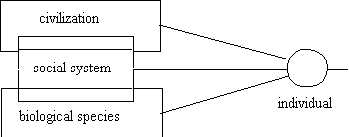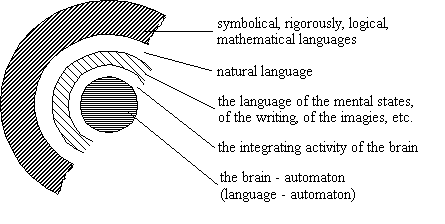Chapter 8
Biology and Psychology in Relation
with Awareness
I. Introduction
The last decades have known an increasingdevelopment in brain
research1
and although important progress has been achieved, the question
marks have not vanished: they have become even more acute ! Even
the use of neuro-cybernetic models has not solve much in terms
of understanding the awareness phenomenon. And an other
phenomenon with no solution so far is that of the integrative
activity of the brain, an intermediate process between the
machine like operation of the brain and the development of its
psychological activity.
The only explanation offered so far is that
such a complex as the brain is has these properties because its
very complexity ! This principle of the explanation stems
from recognizing organization as "a general property
of the matter, just as movement
is"2.
The matter as such can have various levels of organization, from
the simplest to the most elaborate, from inert to alive, to social
and psychological phenomena. N. Botnariuc shows that "delimiting
and defining in a rigorous manner the biological systems from
the lifeless systems is not an easy task since today there is
no strict and rigorous definition of a biological
system"3.
Hence he considers that from the biological point of view the
living matter has four levels of organization: individual; population
or species; biocenotic*
(as represented by biocenozes); and biosphere. The man is located
among these biological levels but overtakes them via the psychological
and social factors.
No doubt that the most complex organization
is offered by the central nervous system. Organization
as stated by N. Botnariuc, envelops two essential aspects: structure
and functions; to these one adds the informational properties.
By extension, if we are to consider the levels of material organization
that goes beyond the biological factor, we also include: modelling
the surrounding reality, taking decisions, afectivity, motivation
and purpose, will. And last but not least we consider the
phenomenon of awareness (more precisely the undercurrent
of beingness in awareness) and the phenomenon of integratory
brain activity, the latter asking for even more thought.
"Structure ... does not limit itself
to shape, morphology, system architecture, but also implies
knowledge of the contents, i.e. of the interactions
between the various morphological
components"4.
This beautiful definition of the structure is applicable both
to the solid body, to the placement of atoms in the crystal structure,
and to the psychological processes, to mental structures and to
their modus operandi. To each of us the model of external world
is a mental structure reflecting this world. It is a product
mostly social in origin; this property is also present when a
fresh mind is opposed to an old model, thus presenting to the
general audience a revolutionary new model. True as it is, this
model stays as a mental structure in the psychological organization
of the mind; it also enters the social consciousness which
is preserved in artificial storage capacities too such as written
documents or modern information retrieval systems.
"The function of a system expresses the
relationship between the system and the hierarchical higher
system in which the former is
integrated"5.
Thus N. Botnariuc gives to the function the role of connecting
the various levels of organization in system hierarchy. The function
of a living creature thus appears as subordinated to the immediately
higher hierarchical level, i.e. the species. But for man the higher
level might be social factor. Can we then put the equal sign between
species and social organization, the latter being viewed as a
biological property of the human species ? The social factor has
no doubt a strong biological component, but we feel it not only
as a species, but as something more complex, as a system; such
a system might have biological qualities, being in the same time
the mode in which the species is organized. In fact the social
system is connected not only to the biological factor but also
to the spiritual life of the people, to the civilization that
the society builds. The social system also has specific, non-biological,
functions. These are the reasons for which man's higher level
is not only the species, but a combination of species, system
and civilization (Fig. 16).

Fig. 16
The mental, psychological activity is at a
large extend informational. Information has also gained
its own existence due to the technical system that man has created.
Such technical systems that operate with information can have
their own models of the surrounding reality corresponding to their
tasks, they can take decision, can fulfil target oriented task,
etc. Man has been able not only to work and communicate with his
fellow men, but also to extract information from his mental
structures and to utilize it as a new tool inside various devices
and technical systems, thus giving to the inert nature a certain
liveliness, bringing it more closely to this way of operation.
Man's information handling is done
via languages, both natural (speaking, reading,
writing) as well as visual (iconic) or of psychical states; but
also we shall include specialized languages, such as those of
mathematics or of computer programming. Via languages man
use dynamic information, partly created, partly deduced
from the surrounding reality. Language appears as a dynamic informational
property of man, used for communicating with fellow men, but also
designed and built by him. The blueprint of a ship, of a factory,
is based on language. The language also contains, as we have seen,
several layers (Fig. 17).

Fig. 17
* Relationship between various species.
Biology and Psychology in Relation with Awareness
58







